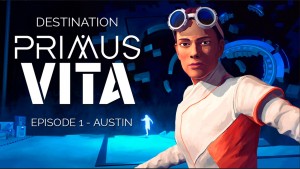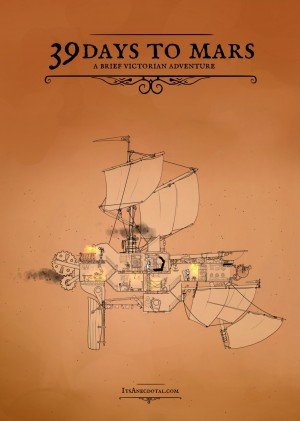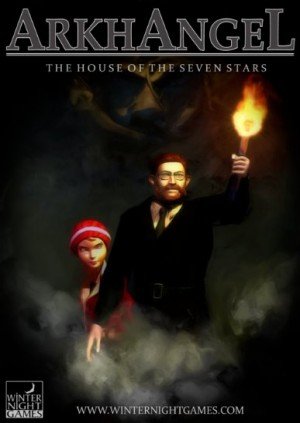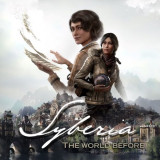Review for Another Sight page 2
More and more games of late have begun exploring the notion of blindness. A seemingly paradoxical concept for a visual medium, it presents obvious challenges that usually rely heavily on echolocation to overcome. Like a bat sending out sound waves or a submarine’s sonar, echolocation uses acoustics to create awareness of the environment without sight. In video games, however, that ability still needs to translate into something to actually see (with the exception of the audio-only BlindSide), so titles like Blind and Perception have enabled players with a kind of temporary outline vision whenever a sound is heard (or in the case of Beyond Eyes, when other senses are engaged as well). This works well enough for games that don’t require much physical prowess, but for obvious reasons such a disability is limiting in what it allows the protagonist to do. Right? Well, hold on.
Instead of being another first-person creeper in the dark, Another Sight is much more ambitious. This side-scrolling puzzle-platformer stars not one but two playable protagonists, one of whom is a little girl that is effectively blind, while the other is a cat. This game also uses sound vibrations to create images for the former to navigate, but here the visual acuity of its sightless heroine is extremely limited for the most part, and yet far more is asked of her than her more leisurely contemporaries. Her feline companion is theoretically available to increase her range, but rarely effective at doing so, instead serving more as a puzzle complement who does the bulk of the running and jumping required. It’s a noble endeavour, but ultimately not a particularly successful one, alternating between stumbling around in the dark and performing janky acrobatics on four legs. It sure does look pretty, though – at least when the lights are on.
Set sometime in the 19th century, the story is needlessly vague and frustratingly cryptic even when a few narrative tidbits are thrown the player’s way. With no preamble at all, a little blonde girl named Kit, cute as a button in her lovely purple dress and bow in her hair, finds herself alone in a strange rocky tunnel beneath London’s metro construction, lost and separated from her father. Matters go from bad to worse soon enough when the floor crumbles between her feet, sending her tumbling and knocking her unconscious. She awakens in the presence of an orange striped cat but without her sight other than a small bubble immediately around her. With nothing to do but press on, the two begin their shared adventure to find a way out.
The further Kit and cat go, however, the deeper they end up descending, and gradually stumble upon a number of shockingly famous figures, who for varying personal reasons all seem intent on finding a mysterious “node,” the world’s greatest source of mystical energy. It’s strongly implied that Kit is intrinsically connected to the node and is best equipped to find it, and that the cat exists to help her do so, though why either is the case is never properly explained. I suppose this is meant to create a sense of wonder and mystery, but all it ever did was confuse me while providing a paper-thin justification for such absurdly inexplicable encounters. Many times along the way Kit comments on how otherworldly everything seems, questioning whether she’s really just dreaming, so I know it’s not just me.
The girl-falls-though-a-hole-to-another-world premise has a kind of Alice in Wonderland vibe at first, but the more I explored, the more it starting feeling like Journey to the Center of the Earth. Miraculously, deep underground are entire ecosystems filled with lush oversized gardens being painted by Monet, ancient stone ruins, purple mist and flowing waterfalls, rivers and sluices and locks, rocky canyons pulsing with electricity under the watchful eyes of rivals Tesla and Edison, a small but highly-mechanized deserted town, and even an underwater sea filled with whales, jellyfish, coral and rays. By the time I reached a not-so-imaginary version of the Nautilus, I wasn’t at all surprised to find that indeed Jules Verne himself had been drawn to the mystery node for inspiration. As if that weren’t weird enough, there are also psychedelic detours to a gravity-defying, giant clock-themed world, as well as a trip through an impressionistic version of the outskirts of Paris. It makes no sense at all, but outside the dull factory levels and sewers, I thoroughly enjoyed soaking in the sights.
Of course, doing so poses a very fundamental problem for a blind protagonist. And indeed, you can only appreciate all this visual splendour when playing as the cat. While controlling this feline, whose name we eventually discover is Hodge, the environments are presented like any other game. As Kit, however, the screen turns almost completely dark apart from her own small glowing radius and any other parts of the scenery highlighted by ambient noises, which can be few and far between. In a nice touch, what is visible has a painterly effect, but it’s so understated and overwhelmed by blackness most of the time that the impact is largely wasted.
Naturally, each of the two characters has their own unique abilities, which is a great setup for some cooperative tasks. Kit can throw switches, open (some) doors, climb ladders and shimmy across ledges, while Hodge can run and jump and climb. Often this requires the pair to work together. Venture ahead as the cat, for example, and have Hodge stand on a pressure plate to enable access elsewhere for Kit, who then may need to find a lever to activate a lift to get Hodge back to her. Given their limited capabilities, there isn’t a lot of diversity in the obstacles facing them, but occasionally a new wrinkle is thrown in for added complexity, such as using Kit to reflect light beams off rotating mirrors or operating giant moving magnets to build makeshift bridges.
One particular music puzzle instigated by a rather insane Claude Debussy requires repeating a tune on a room-sized pipe organ, which isn’t hard so much as a tedious exercise in patience to figure out which key triggers which note, with the organ resetting each time you hit the wrong one. I was exasperated by end of it, so imagine my joy to find it repeated later on. Ironically for a game about blindness, this puzzle is hearing-sensitive, as it can be completed through visual cues rather than a good ear.
Solving puzzles with Kit is rarely the real challenge, merely finding the few slightly-glowing objects in the inky blackness that she can actually interact with – a problem exacerbated by her understandable but tiresomely slow walking speed and occasional need for backtracking. Any time I got stuck, it was inevitably because I’d missed a hard-to-see mechanism while squinting at the tiny lit area available at any given time. While even that surely doesn’t come close to the frustration that real blind people experience every day, that doesn’t make it any more enjoyable in a game for sighted players.
Hodge gets most of the platforming duties, as you’d expect, but unfortunately the clumsy controls and poor implementation make these sequences more annoying than fun. Another Sight can be controlled with either keyboard or gamepad, but this puss basically only has two directions: vertical and horizontal. Attempting any kind of diagonal leap upwards means jumping straight up and quickly sideways to improbably reach out and grab a ledge in mid-air. This looks silly and feels counter-intuitive, although at least it actually works. The same can’t be said for downward movement, which is hyper-finicky and SUPER-easy to overshoot a landing and plummeting to your death.
Kit isn’t totally immune to a bit of hopping about herself, which as you can imagine is even harder as a blind girl, but the game has a clever solution to this. In order for her to even attempt a jump, it is necessary for her to essentially “see” her landing spot. Her own aura doesn't emit enough light, so you’ll need to manipulate the environment somehow to gently illuminate a larger area in front of her, whether by activating dormant machinery or even having Hodge get close enough on the other side and make a ruckus. Smart. And then Kit proceeds to make such a feeble jump that she bounces off the target and dies. Aaauughh!!
Either character dying results in respawning at a checkpoint close by, but Another Sight treats the reset as if both protagonists are dead. So if you’ve made progress with Kit only to see Hodge fail to stick a simple ledge-drop for the millionth time (or vice versa), you’ll not only have to get one protagonist back to where they were, but the other as well. This isn’t too big a nuisance until the final quarter or so of the game, when it turns into a lengthy, torturous stealth experience.
Full disclosure: I’m not much of a stealth fan at the best of times, but when done well I can certainly appreciate a sneaky approach (the Splinter Cell series is among my all-time favourites). Alas, Another Sight is closer to the worst of times in this respect. (Dickens should have been down here!) It starts out promisingly enough, as any places Kit can hide are clearly highlighted, but it all goes downhill from there. Guards aren’t just NOT blind, but apparently have eyes in the back of their heads too, so even if you think you’ve waited long enough for them to pass, you may still get nabbed by darting out too quickly in a race for the next cubby hole. If only that were the biggest transgression.
Hodge’s ability to meow becomes an integral part of the experience at this point, so it’s absolutely unforgivable just how useless this feature actually is. The goal is to have him distract a guard so that Kit has time to reach the nearest hiding place, which makes perfect sense, except that they’re rarely very distracted! Often they’ll react and turn in place, but this isn’t nearly good enough to help, so you’ll need to get them to actually pursue you. But if there’s a secret to making that happen consistently, I never did find out what it was. All I could do was yammer constantly like a fool until finally a guard would follow me a few feet, only to do it all over again to draw them a little further. I love cats, but even I wanted to punt Hodge off a ledge by the time I finished playing. (Not really, PETA, relax.)
Finally, adding insult to deadly injury, is the combo stealth AND platforming area, in which you must get both Kit and Hodge to the bottom of a rickety scaffold with multiple levels and numerous guards patrolling either side. Between Hodge’s fruitless meowing and Kit’s inability to make even minor jumps and the usual challenges of making one’s way in the dark, plus the backtracking from both characters whenever one of them failed, this was an agonizing segment that took me far longer than it should have, even with periodic autosaves along the way.
Other than traumatizing me for life with the sound of feline meows, Another Sight makes excellent use of sound, which is a good thing when so much of the time is spent in the dark. Musical scores range from ominous orchestral pieces to haunting synth, funky industrial and even classical piano, while generators rumble noisily, water drips in echoing caverns, crows caw and rats squeak and raw electricity crackles authentically. Kit regularly muses to her furry companion and has an absolutely delightful English accent that sounds age-appropriate, while the supporting cast is performed equally well, though only in small cameo roles.
While progress is strictly linear, along the way are some harder-to-reach collectibles that unlock character bios and other information about the bizarre environments you traverse. I was hoping this would fill in the many huge narrative gaps forming throughout my travels, but mainly they answered only the questions I wasn’t really asking.
Unfortunately the game wasn’t particularly stable for me, as three different times I found myself unable to move when starting a new area. I couldn’t even escape out at that point, forcing a hard exit and then restart to continue. On the plus side, the timing meant that I didn’t lose any progress apart from having to rewatch the same chapter intro cutscenes.
It seems like I have more negative things to say about Another Sight than positive, which is partially warranted and yet a little unfair. There are actually quite a few things to admire about the game throughout its six or so hours of play time, from its excellent production values to some clever dual-character puzzles, and of course its willingness to push an unusual premise in a more ambitious direction than other blindness-themed adventures. Had this been a shorter, tighter experience of half the length, I suspect the tone of this review would be much different.
However, between the abstract story never really making sense, some dodgy platforming controls, the inherent challenge of spending at least half of the time inching forward in the dark, and a lack of new abilities introduced for more creative problem-solving, the game’s conceit was already starting to wear out its welcome before the ill-fated decision to finish with an interminable stretch of horribly-implemented stealth mechanics. The latter in particular left something of a bad taste in my mouth that the first half-plus really doesn’t deserve. Ultimately, then, Another Sight ends up a rather middling puzzle-platformer with interesting ideas that run out long before the game does, and a number of other frustrations along the way. If you can look past its shortcomings, there’s some enjoyment to be found in the secret world beneath old London, but anyone hoping for a polished side-scroller should move right along, as there’s not just enough to see here.
































